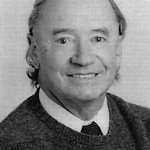Person
Barker, John Adair (1925 - 1995)
FAA FRS

John Adair Barker
Details
- Born
- 24 March 1925
Corrigin, Western Australia, Australia - Died
- 27 October 1995
California, United States of America - Occupation
- Theoretical physicist
Summary
John Barker worked at IBM Research Laboratory (later the Almaden Research Center), San Jose, California 1969-1994. He has made major contributions to our knowledge of solutions and dense vapours by his work on the statistical mechanics of molecular interactions, especially of polar molecules.
Details
Chronology
- 1945
- Education - BSc (hons), University of Melbourne
- 1946 - 1947
- Career position - Demonstrator in physics, University of Melbourne
- 1948
- Career position - Scientist, Division of Aeronautics, Council of Scientific and Industrial Research (CSIR)
- 1949
- Career position - Mathematics teacher, Acton Technical college, England
- 1950 - 1967
- Career position - Scientist, Division of Industrial Chemistry, CSIRO
- 1958
- Education - DSc, University of Melbourne
- 1967
- Award - Fellow, Australian Academy of Science (FAA)
- 1967 - 1969
- Career position - Professor of Applied Mathematics and Physics, University of Waterloo, Ontario
- 1969 - 1994
- Career position - IBM Research Laboratory (later the Almaden Research Center), San Jose, California
- 1981
- Award - Fellow, The Royal Society, London (FRS)
Related entries
Published resources
Journal Articles
- Rowlinson, J. S., 'John Adair Barker 1925-1995', Historical Records of Australian Science, 11 (2) (1996), 179-190. https://doi.org/10.1071/HR9961120179. Details
Resources
- Biographical Memoirs of Fellows of the Royal Society, Royal Society of London, https://doi.org/10.1098/rsbm.1996.0002. Details
- Wikidata, http://www.wikidata.org/entity/Q21165582. Details
- VIAF - Virtual International Authority File, OCLC, https://viaf.org/viaf/165867217. Details
- 'John Barker - Citation at year of election, 1967', Fellows of the Academy, Australian Academy of Science, 2019, https://www.science.org.au/profile/john-barker. Details
- 'Barker, John Adair (1925-1995)', Trove, National Library of Australia, 2009, https://nla.gov.au/nla.party-1476019. Details
Resource Sections
- Ward, C., 'John Adair Barker [1925-1995]', in CSIROpedia, Commonwealth Scientific and Industrial Research Organisation (CSIRO), 2011, https://csiropedia.csiro.au/Barker-John-Adair. Details
See also
- Ewers, W. E.; and Weiss, D. E., 'Keith Leonard Sutherland 1916-1980', Historical Records of Australian Science, 5 (2) (1981), 78-88. https://doi.org/10.1071/HR9810520078. Details
Digital resources
Rosanne Walker; Ken McInnes
Created: 11 March 1998, Last modified: 15 March 2023
